Family : Lycaenidae

Text © Dr. Gianfranco Colombo

English translation by Mario Beltramini
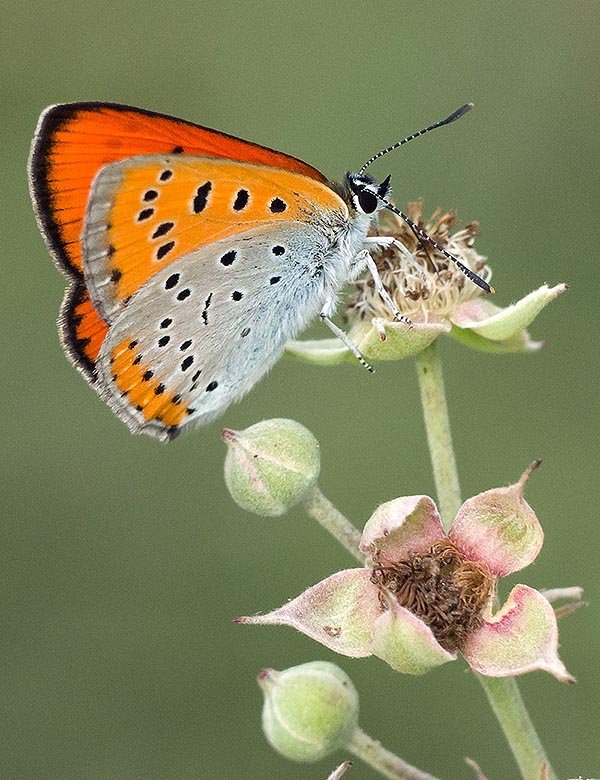
The lycaena dispar is an Euro-Asian species of the medium-temperate belt © Gianfranco Colombo
As often occurs in the naturalistic world, the research of the etymological origin of the scientific names given by the first classifying scholars to the various species of insects, often falls into the fantasy and in the mere supposition as frequently the author, did not mention the original reason that had led him to assign that such name to that particular species.
Often they were names coming from histories reported through the time and that had nothing to do with the analyzed species, other times they were real errors of interpretation whereas then true misspellings done while reporting terms coming from the old Greek or from the modernized Latin.
Also the same Linnaeus and his faithful pupils have left us, their descendants, the task to imagine what they had wanted to mean through the assignment of a practically invented scientific name or without any historical reference and much less certain. The scientific literature is chock-full of such interpretations.
When in 1803 the English entomologist Haworth did classify this quite beautiful lycaenid, his attention was certainly attracted by the evident dimorphism between the two sexes, so much to convince him to give to the species the Latin name dispar = dissimilar, not as much for the size and the shape that might already by themselves put the doubt of a different species but by the drawing of the upper face of the wings, clearly different in the two genera.
As known, the male exhibits a bright auburn/golden colouration that magnificently reflects its colour when exposed to the sun whilst the female is darker, very spotted and with a slight orange shade. Furthermore, its size is markedly bigger.
Conversely, the etymology of the genus Lycaena has vague and different interpretations. Some maintain that it comes from Lycia, an epithet of the goddess Diana, some from lukaina = she-wolf, others from Lukaios or Lycaeus of Lyceus, the name given to some gods worshipped on the mount Lycaeum in the old Arcadia. Still others from Lykaon, king of Arcadia or from Lukeion, a gymnastics school of old Athens where the mastery of the gymnasts was said to imitate the frantic flight of this butterfly.
Finally, the most fanciful, that puts in relation that which was deemed as “scientific inventiveness” with a simple and profane rhymed and rhythmic repetition of the names scientifically used in those times and that, together, later did gave credit to the most different interpretations: Zygaena, Phalaena … Lycaena.
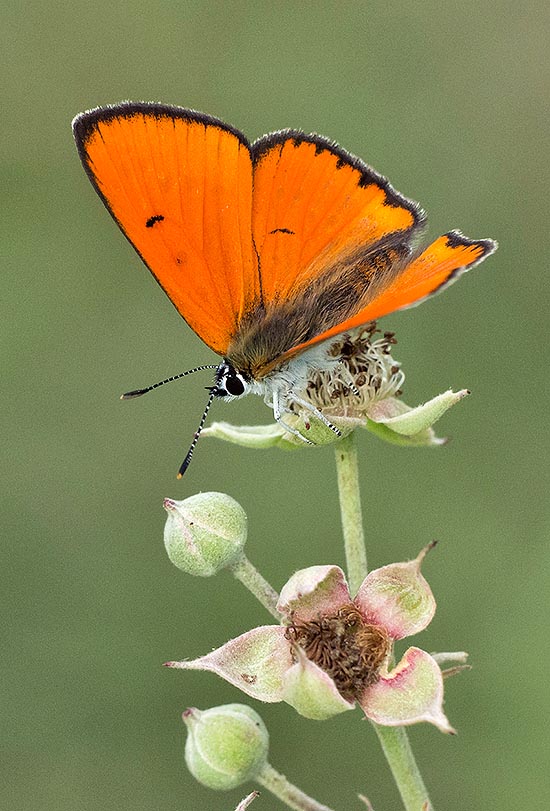
Typical of the swampy zones, however humid and rich of water, is just passing other ambients © Gianfranco Colombo
The Large copper, Lycaena dispar (Haworth, 1802) belongs to the order of the Lepidottera and to the family of the Lycaenidae a group of butterflies of averagely reduced size, with extremely lively colours and present in all continents.
During the last decades when suddenly this butterfly began to disappear from our countries, immediately the protectionist associations indicated the entomologist collectors as the main culprits of this decrease due to their indiscriminate chasing. And we have to think that at that time, only very few did know this butterfly and even less they did know how to classify it.
The nonsense of this assertion was clear but we have the tendency to sustain that part of the damage has been and is still caused by these lovers. Rather, it is evident to everybody, profane or specialist whatever, to understand that the sudden and immediate disappearance of this lycaenid, along with many others less showy but also subject to this fate, is caused by the abrupt change of the agricultural activities in our lands.
It is sufficient to walk along a country road and to try to remember how it was thirty or forty years ago and immediately we shall get the logical answer without looking for fanciful motivations.
This small butterfly has become in many European regions the symbol of the protection of the environments on the way to the ambiental degradation standing among the many unaware victims, this species results being one of the most affected by the tampering made by the man to the natural ambient.
It is sufficient to observe what happens in the United Kingdom talking of the large copper, rightly our butterfly. The only hint is like mentioning an unattainable chimera, a pipe dream, an incessant struggle in the attempt to reintroduce the species after its extinction in the mid-nineteenth century. The Anglo-Saxon entomologists carefully sift every year every corner of their country looking for this small and pretty butterfly and its occasional and now rare finding always makes sensation and gives hope for its future resettlement in an area that saw it presence since ever. It is perhaps the most coveted prey for an Anglo-Saxon entomologist.
Also in other European regions have been noted during the last decades drastic reductions and disappearances of the quite numerous colonies that once inhabited them. Reclaimations of wetlands, sometimes natural drying ups of peatlands or humid zones, and intensive agriculture that has resulted in deep clearings and plowings into the ground with consequent disappearance of permanent meadows, landfills of small resurgences, lowerings of the water table due to immoderate withdrawals upstream, agricultural modifications with introduction of non-traditional crops, conditions that have modified in a large extent the look of our country and that have caused at times the disappearance of a great number of lepidopterans, in particular the lycaenids.
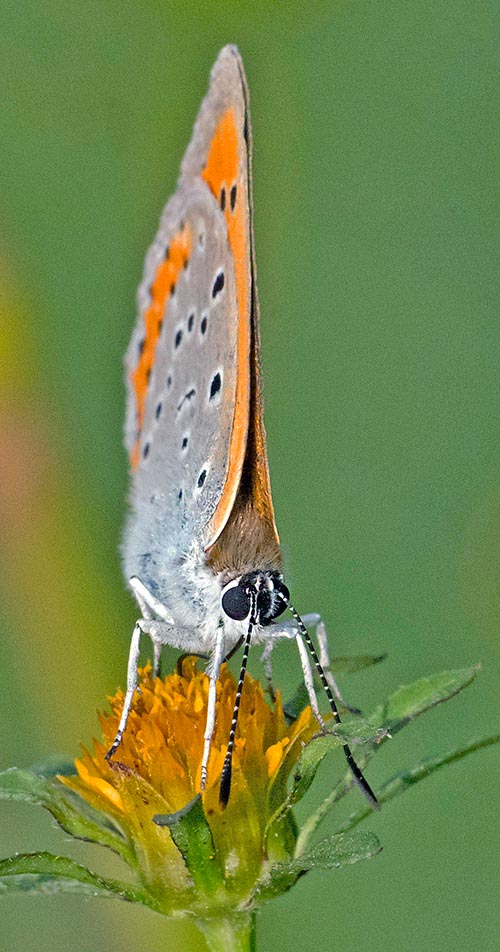
Basically when perched keeps the wings vertically closed © Gianfranco Colombo
The Po Valley and particularly the area over the line of the resurgences, has been, on the contrary, able, with a lot of difficulty, to overcome this tumultuous period and during these last times it is even climbing the slope that saw it like in other areas reducing to worrying levels.
It is clear that the population of the Lycaena dispar is not any more at the levels of half a century ago but is however present and diffused in the whole foothills and in some years it results as having very consistent colonies, well stabilized, and, as said before, at times even progressively increasing.
In the same areas we can note at times decreases and even total disappearances of colonies present since ever during the earlier decades.
Some districts to which was once guaranteed a periodical irrigation with waters drawn from nearby rivers, have seen today this traditional practice, either for a reduced availability of water or even more for the irrigation of the monocultures that requires high consumptions and well greater irrigation employment times. The deep plowings of the ground absorb more quickly the flowing water and in the meantime are subject to a faster evaporation due to the increased permeability of the ground. More distributed water but more dried soil.
Yes, have ended the times of autumn shamrock or of Italian millet spotted by pink inflorescences (yes, because the Lycaena dispar loves dispassionately and inexplicably the flowers of this colour) of yarrow, of creeping thistle, of centaury, of asters or of pincushion flowers. Also of water meadows and forced fields for the spring grass production. However, two important variables have added, “one against the other armed”, that affect the survival of populations decimated by this lycaenid: the first is an unexpected help for the species, the second, when implemented, highly dangerous.
Now much of the irrigation takes place through forced exploitation of artesian water by means of tractors that fish from underground in artificial wells or even directly from the same irrigation ditches that cross our countries.
This new modality has practically excluded and therefore obliged to abandon the use of the small derivation mouths of the carrying rods, leaving uncultivated the bank vegetation and so giving the possibility to those insects that nourish and develop of the essence living here, to complete their metamorphic cycle.
Furthermore, it has been now abandoned the use to set on fire these banks for getting rid of the infesting weeds. Finally, also the ditches of carrying rod, once kept “razed on the banks” and “well washed on the bottom” to scroll through the water better, have been nowadays abandoned to themselves seen that these once negative factors, now have little effect on the potential of modern water pumps.
All this has allowed the creation of a micro riparian habitat fairly florid and rich of the essences preferred by our large copper.
Host plants such as the Rumex hydrolapathum, Rumex crispus, Rumex aquaticus and Polygonum bistorta have found in fact their ideal ambient and have considerably developped and undisturbed along these small drains.
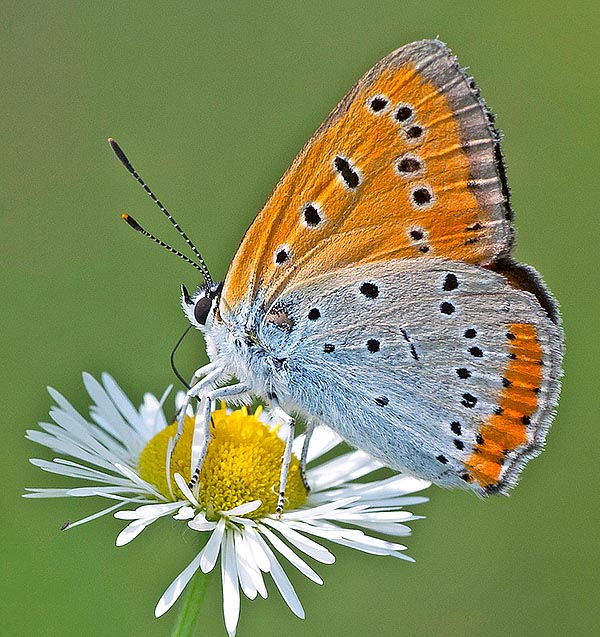
Seen from the side, Lycaena dispar shows the usual tiny down and dottings characteristic of the Lycaenidae, but here is a typical orange-reddish belt on the edge of the lower wing © G. Colombo
Moreover, they have generated the spontaneous growth of those so much loved and necessary floral essences necessary for the feeding of these butterflies. Sweet inflorescence such as the water and the wild mint, the hemp-agrimony, the three-lobe beggarticks and not rarely, the Lady’s thumb Polygonum persicacea are the most diffused in these small ditches.
Conversely, is deleterious the introduction of the practice of chopping the bank weeds with extremely effective machineries that practically destroy all what they find at their passage, activity that however appears to be confined to the only ditches of important flow.
The result is that the Lycaena dispar is presently well located in the whole resurgences area and seems having passed albeit with great difficulty, the perspective of the last decades of a possible disappearance.
As said before, our swamps large copper does not have local vulgar names distinguishing it from the other butterflies and the only scientific name simply identifies the habitat where it was usually found.
Conversely, in the European common names is always indicated its coppery colour. Large copper – in English, Grand cuivré or Cuivré des marais – in French, Grosse Feuerfalter – in German and Grote vuurvlinder – in Dutch.
Zoogeography
The large copper is an Euro-Asian species living in the medium temperate range. In Europe, it is amply distributed although missing totally in some regions and found only in suitable sites.
It is extinct in Geat Britain and in Ireland and in several European areas historically occupied. Northwards it reaches the southern part of Finland and Estonia and through Russia and the central Asian republics up to Mongolia.
Southwards, from France and Italy, eastwards to occupy the whole Balkan Peninsula, Turkey, Caucasus to rejoin in the north of China.
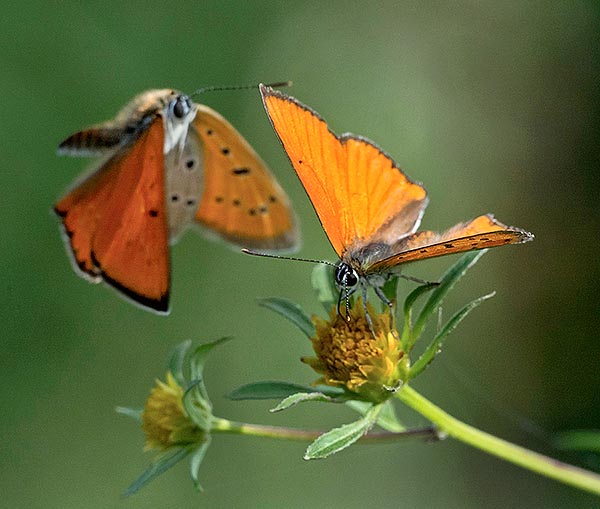
Two male suitors. The flight can be very fast. Agility, sprints and huge muscle strength © G. Colombo
Three different subspecies have been classified in Europe occupying well distinct areas and although somewhat similar in the morphology, show different biological characteristics. The Lycaena dispar dispar, the ssp now extinct in England and Ireland, the Lycaena dispar batavus typical of Netherlands and the Lycaena dispar rutilus in the remainder of the range.
Ecology-Habitat
The large copper is typical of humid areas, of swampy zones and of lands rich of water. It is difficult to meet it in arid zones if not accidentally during its short movements between the various occupied areas. Its has a very fast and linear flight during these errations whilst the traditional flight is a typical lycaenid one, even more frantic in the movements seen its bigger aerial agility and brawn. As a matter of fact, it is much more robust than many other congeners.
It has sudden jerks that make it appear and disappear from view whilst when perched, usually calms down and while savoring the sweetnesses of its choice essences, is easy to observe and approach.
Basically, when perched keeps the wings vertically closed but does not fail to rub the two surfaces of the wings, as customary to the members of this family, opening them often, particularly at the appearance of the sun rays.
Morpho-physiology
The Lycaena dispar is fairly attractive and showy if it were not for its reduced size that frequently render it poorly visible. The wingspan does not exceed the 40 mm, slightly less in the male. We often marvel of the colours of some exotic butterflies with wings adorned with those intense blues or by spectacular greens so much evident and enhanced by the enormous size of these lepidopterans, forgetting that if also our lycaenids had these size probably they would result even more dramatic.
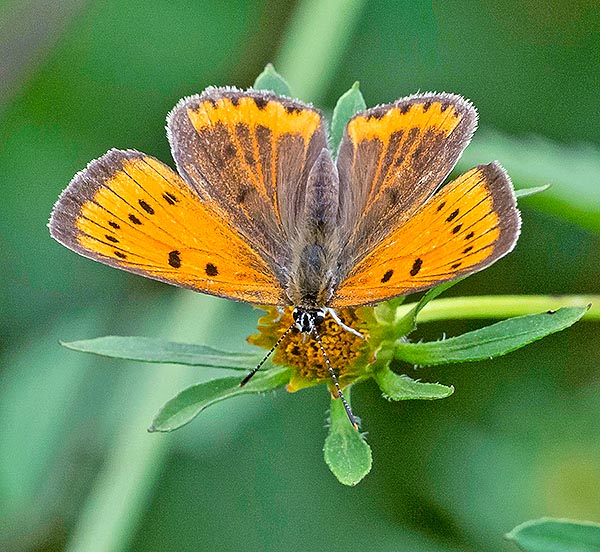
The female, once thought another species, has pale, brownish colours with suffused amber down © Gianfranco Colombo
The large copper shows on the upper face of the wings an incredibly bright golden/copper colour that unluckily cannot be appreciated when resting. A so much lively and bright colour that it is visible tens of meters away when observing a flowery meadow, its figure stands out practically on whatever inflorescence it is perched.
The flight is frantic and agitated, with sudden turns and abrupt stops that make it literally disappear before the eyes when suddenly stops on a flower keeping the wings closed. Then, like all lycaenids, by the first ray of sun here it is opening again its coloured casket emphasizing its fantastic reflections.
The male has the upper face totally of this colour surrounded on the margins by a distinct black line in turn bordered externally by a white smear. On the hind wings it shows some small black lunettes. In the front discal area are just hinted two very fine small black speckles.
On the contrary, the female has paler and fairly brownish colours though always coppery. The upper face shows a series of roundish spots that in the fore as well as in the rear post-discal follows parallel the border of the wings. The basal area and hind discal is interested by a suffused amber down that partially covers the alar surface.
The lower faces of the wings of both sexes are equal and evidence the typical scattered dotting of the lycaenids, with fore wings with orange bottom and the hind one bluish pearl. On the lower margin is present an orange-reddish strip more or less ample that is peculiar for the determination of this species.
In fact, this lycaena can be easily mistaken with the Lycaena virgaureae, with the Heodes ottomanus and the Thersamonia thetis typical of the Balkan Peninsula and also with the Chrysophanus (Palaeochrysophanes) hippothoe, hippothoe, if not for this particularity.
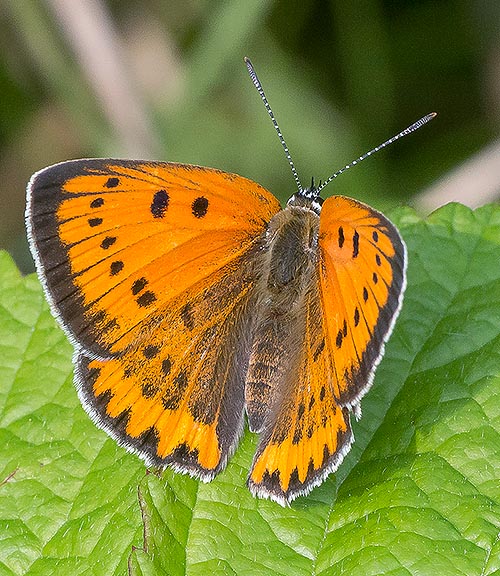
The eggs are laid singularly on the lower side of essences of the genus Rumex. During the winter the small caterpillar wraps of a thick and transparent web that keeps it anchored to the dry leaf. It will visibly grow with the spring awakening © G. Colombo

Ethology – Reproductive Biology
Unlike many other lycaenids that complete the last stages of their life with the help of some species of ants, this butterfly has an autonomous life like the traditional lepidopterans.
In fact, the caterpillar is not taken and cared by any type of ant to conclude its metamorphosis but proceeds in all its moults remaining on the host plant till the complete maturation.
The butterfly lays the eggs on essences of the genus Rumexand develops slowly for months pupating on the same leaves of the host plant, till the final fledging.
The caterpillar is green emerald but when active camouflages easily along the robust ribs of the leaves of the host plant of which generally consumes only the lower surface not revealing its presence. Conversely, at times it causes perfectly round holes that pierce the leaf.
The cjrysalis is a small wad of silky and waterproof material where the caterpillar remains conserved along all winter months. It can also remain submerged in the water and ice for sime time without any damage.
In southern Europe the subspecies Lycaena dispar rutilusis bivoltine with a spring generation and another in late summer whilst progressing northward the generation becomes unique with autumn hibernation during the first stages of life of the caterpillar.
The Lycaena dispar batavus is in fact univoltine and also the Lycaena dispar dispar of Great Britan falls in this category. The eggs are laid individually on the lower side of the leaves and during the winter the small caterpillar wraps with a thick and transparent web that keeps it anchored to the dry leaf until the arrival of the first spring warmth. Upon its wakening the growth of the caterpillar is rather fast and gives its fruits already by the end of April beginning of May when the first generation fledges.
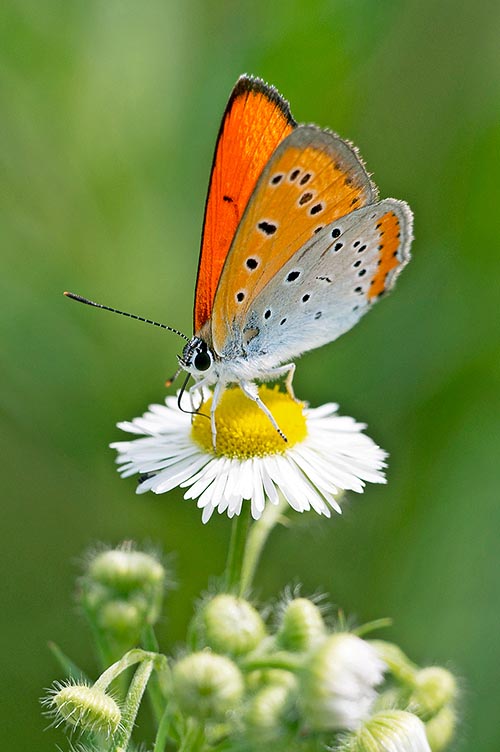
It is an endangered species in all its range and highly protected in almost all Europe © Gianfranco Colombo
The late summer one is instead slower but produces stronger, more vigorous and more numerous specimens that often reach the fledging even in early autumn.
Also in the Lycaena dispar rutilus, in some years having cool or much delayed springs, the first generation seems to be absent or to totall miss.
There is a considerable variability in the flickers of this lepidopteran, caused mainly in the first generation, by the length and rigidity of the winter temperature, by the gradient of humidity and by the arrival more or less precocious of the first spring warmth whilst the second may at times have delays or temporary shortnesses depending on the summer gradient of drought, temperatures and autumn prolongations of the nice season.
This species is not much prolific being subject to strong predation.
It is an endangered species all over its range and strongly protected in almost all Europe.
Who knows if the English poet Alfred Tennyson in his poem “The talking oak” while described lying in the shadow of this huge tree, with rapid and wonderful rhyme this small jewel comparing the reflection of its wings to the lips of his beloved, imagined that this butterfly would later disappear?
Let us allow him the illusion that it has remained at its place and that by fluttering among the ferns revives his memory.
“Sometimes I let a sunbeam slip,
To light her shaded eye,
A second flutter’d round her lip,
Like a golden butterfly”.
Synonyms
Papilio dispar Haworth, 1803; Chrysophanus dispar Haworth, 1803; Thersimom dispar Haworth, 1803;
Polyommatus hippothoe var. dispar Haworth, 1803.
→ For general information about Lepidoptera please click here
→ To appreciate the biodiversity of BUTTERFLIES and find other species, please click here.
